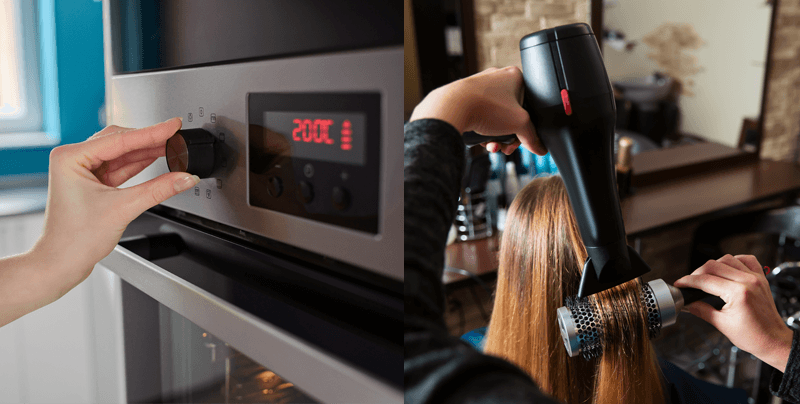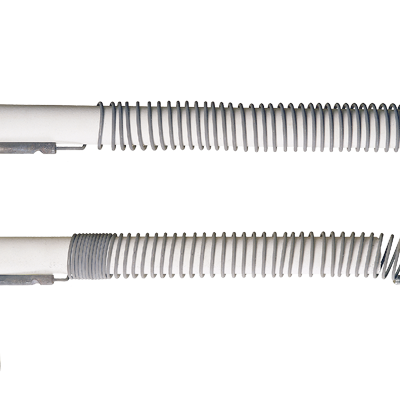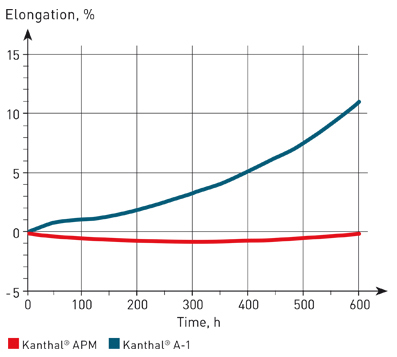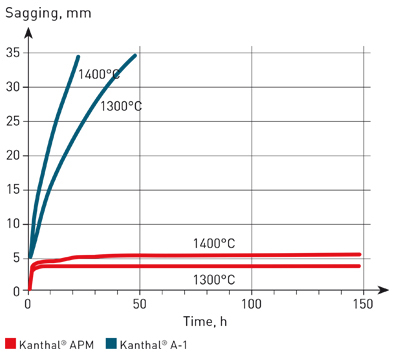Content:
Kanthal advantages
Kanthal® APM heating material
Creep rupture strenght for industrial wire 4 mm
Elongation at 1300°C element temperature
Sagging test diameter 9.5 mm, 1300°C and 1400°C, 300 mm between supports
Physical and mechanical properties
Up to 1425 °C 2560 °F: KANTHAL® APM
(Normally used in furnace applications).
Up to 1400 °C 2550 °F: KANTHAL® A-1
(Normally used in furnace applications).
Up to 1350 °C 2460 °F: KANTHAL® A
is used for appliances, where its high resistivity and good oxidation resistance are particularly important.
Up to 1300 °C 2370 °F: KANTHAL® AF
has improved hot strength and oxidation properties and is especially recommended where good form stability properties in combination with high temperature is required.
Up to 1300 °C 2370 °F: KANTHAL® AE
is developed to meet the extreme demands in fast response elements in glass top hobs and quartz tube heaters. It has exceptional form stability and life in spirals with large coil to wire diameter ratio.
Up to 1300 °C 2370 °F: KANTHAL® D
Employed chiefly in appliances, its high resistivity and low density, combined with better heat resistance than austenitic alloys, make it suitable for most applications.
Up to 1100 °C 2010 °F: ALKROTHAL®
is typically specified for rheostats, braking resistors, etc. It is also used as a heating wire for lower temperatures, such as heating cables.
Kanthal® advantages
Higher maximum temperature in air
Kanthal® A-1 has a maximum temperature of 1400 °C 2550 °F; Nikrothal® 80 has a maximum temperature of 1200 °C 2190 °F.
Longer life
Kanthal® elements have a life 2-4 times the life of Nikrothal® when operated in air at the same temperature.
Higher surface load
Higher maximum temperature and longer life allow a higher surface load to be applied on Kanthal elements.
Better oxidation properties
The aluminum oxide (Al2 O3) formed on Kanthal® alloys adheres better and is therefore less contaminating. It is also a better diffusion barrier, better electrical insulator and more resistant to carburizing atmospheres than the chromium oxide (Cr2O3) formed on Nikrothal® alloys.
Lower density
The density of the Kanthal® alloys is lower than that of the Nikrothal® alloys. This means that a greater number of equivalent elements can be made from the same weight material.
Higher resistivity
The higher resistivity of Kanthal® alloys makes it possible to choose a material with larger cross-section, which improves the life of the element. This is particularly important for thin wire. When the same cross-section can be used, considerable weight savings are obtained. Further, the resistivity of Kanthal® alloys is less affected by coldworking and heat treatment than is the case for Nikrothal® 80.
Higher yield strength
The higher yield strength of Kanthal® alloys means less change in cross-section when coiling wires.

KANTHAL® APM HEATING MATERIAL

Kanthal® APM is a resistance material which can be used to improve the performance at high temperatures, where conventional metallic elements are getting problems like bunching, creeping, oxide spallation and to open up new applications where metallic elements are not used today.
The great advantages of Kanthal® APM are:
Improved hot strength, giving:
- much better form stability of the heating element
- less need for element support
- low resistance change (aging)
- longer element life
Excellent oxide, giving:
- good protection in most atmospheres, especially corrosive atmospheres
- no scaling and impurities
- a longer element life
Creep rupture strength for industrial wire 4 mm
| Time, h | Temperature 1000°C, MPa | Temperature 1200°C, MPa | Temperature 1400°C, MPa |
|---|---|---|---|
| 100 | 5.6 | 3.3 | 1.3 |
| 1000 | 3.4 | 1.6 | 0.5 |
| 10000 | 2.2 | 0.7 | 0.2 |
Elongation at 1300°C element temperature

Sagging test diameter 9.5 mm, 1300°C and 1400°C, 300 mm between supports
Physical and mechanical properties
| Kanthal® APM | Kanthal® A-1 | Kanthal® A | Kanthal® AF | Kanthal® AE | Kanthal® D | Alkrothal® | ||
|---|---|---|---|---|---|---|---|---|
| Max continuous operating temp. | °C | 1425 | 1400 | 1350 | 1300 | 1300 | 1300 | 1100 |
| (element temperature in air) | °F | 2600 | 2550 | 2460 | 2370 | 2370 | 2370 | 2010 |
| Nominal composition (See Note), % | Cr | 22 | 22 | 22 | 22 | 22 | 22 | 15 |
| Al | 5.8 | 5.8 | 5.3 | 5.3 | 5.3 | 4.8 | 4.3 | |
| Fe | balance | balance | balance | balance | balance | balance | balance | |
| Ni | – | – | – | – | – | – | – | |
| Density ρ | g/cm3 | 7.10 | 7.10 | 7.15 | 7.15 | 7.15 | 7.25 | 7.28 |
| Ib/in3 | 0.256 | 0.256 | 0.258 | 0.258 | 0.258 | 0.262 | 0.263 | |
| Resistivity at 20°C | Ω mm2/m | 1.45 | 1.45 | 1.39 | 1.39 | 1.39 | 1.35 | 1.25 |
| at 68°F | Ω/cmf | 872 | 872 | 836 | 836 | 836 | 812 | 744 |
| Temperature factor of the resistivity, Ct | ||||||||
| 250°C (480°F) | 1.00 | 1.00 | 1.01 | 1.01 | 1.01 | 1.01 | 1.02 | |
| 500°C (930°F) | 1.01 | 1.01 | 1.03 | 1.03 | 1.03 | 1.03 | 1.05 | |
| 800°C (1470°F) | 1.03 | 1.03 | 1.05 | 1.05 | 1.05 | 1.06 | 1.10 | |
| 1000°C (1830°F) | 1.04 | 1.04 | 1.06 | 1.06 | 1.06 | 1.07 | 1.11 | |
| 1200°C (2190°F) | 1.05 | 1.04 | 1.06 | 1.06 | 1.06 | 1.08 | – | |
| Linear thermal expansion coefficient α, × 10-6/K | ||||||||
| 20 – 100°C (68 – 210°F) | – | – | – | – | – | – | – | |
| 20 – 250°C (68 – 480°F) | 11 | 11 | 11 | 11 | 11 | 11 | 11 | |
| 20 – 500°C (68 – 930°F) | 12 | 12 | 12 | 12 | 12 | 12 | 12 | |
| 20 – 750°C (68 – 1380°F) | 14 | 14 | 14 | 14 | 14 | 14 | 14 | |
| 20 – 1000°C (68 – 1840°F) | 15 | 15 | 15 | 15 | 15 | 15 | 15 | |
| Thermal conductivity λ at 50°C | W/m K | 11 | 11 | 11 | 11 | 11 | 11 | 16 |
| at 122°F | Btu in/ft2 h °F | 76 | 76 | 76 | 76 | 76 | 76 | 110 |
| Specific heat capacity at 20°C | kJ/kg K | 0.46 | 0.46 | 0.46 | 0.46 | 0.46 | 0.46 | 0.46 |
| at 68°F | Btu/lb °F | 0.110 | 0.110 | 0.110 | 0.110 | 0.110 | 0.110 | 0.110 |
| Melting point (approx.) | °C | 1500 | 1500 | 1500 | 1500 | 1500 | 1500 | 1500 |
| °F | 2730 | 2730 | 2730 | 2730 | 2730 | 2730 | 2730 | |
Mechanical properties* (approx.) |
||||||||
| Tensile strength | N/mm2 | 680** | 680 | 725 | 700 | 720 | 670 | 630 |
| psi | 98600** | 98600 | 105200 | 101500 | 104400 | 97200 | 91400 | |
| Yield point | N/mm2 | 470** | 545 | 550 | 500 | 520 | 485 | 455 |
| psi | 68200** | 79000 | 79800 | 72500 | 74500 | 70300 | 66000 | |
| Hardness | Hv | 230 | 240 | 230 | 230 | 230 | 230 | 220 |
| Elongation at rupture | % | 20** | 20 | 22 | 23 | 20 | 22 | 22 |
| Tensile strength at 900°C | N/mm2 | 40 | 34 | 34 | 37 | 34 | 34 | 30 |
| at 1650°F | psi | 5800 | 4900 | 4900 | 5400 | 4900 | 4900 | 4300 |
|
Creep strength*** |
||||||||
| at 800°C | N/mm2 | 8.2 | 1.2 | 1.2 | – | 1.2 | 1.2 | 1.2 |
| at 1470°F | psi | 1190 | 170 | 170 | – | 170 | 170 | 170 |
| at 1000°C | N/mm2 | – | 0.5 | 0.5 | – | – | 0.5 | 1 |
| at 1830°F | psi | – | 70 | 70 | – | – | 70 | 140 |
| at 1100°C | N/mm2 | – | – | – | 0.7 | – | – | – |
| at 2010°F | psi | – | – | – | 100 | – | – | – |
| at 1200°C | N/mm2 | – | – | – | 0.3 | – | – | – |
| at 2190°F | psi | – | – | – | 40 | – | – | – |
| Magnetic properties | 1) | 1) | 1) | 1) | 1) | 1) | 1) | |
| Emissivity, fully oxidized condition | 0.70 | 0.70 | 0.70 | 0.70 | 0.70 | 0.70 | 0.70 |
Note: Composition listed is nominal. Actual composition may vary to meet standard electrical resistance and dimensional tolerances.
* The values given apply for sizes of approx. 1.0 mm diameter (0.039 in)
** 4.0 mm (0.157 in) Thinner gauges have higher strength and hardness values while the corresponding values are lower for thicker gauge
*** Calculated from observed elongation in a Kanthal standard furnace test. 1% elongation after 1000 hours
**** Composition listed is nominal. Actual composition may vary to meet standard electrical resistance and dimensional tolerances.
1) Magnetic (Curie point approx. 600°C (1100°F))
